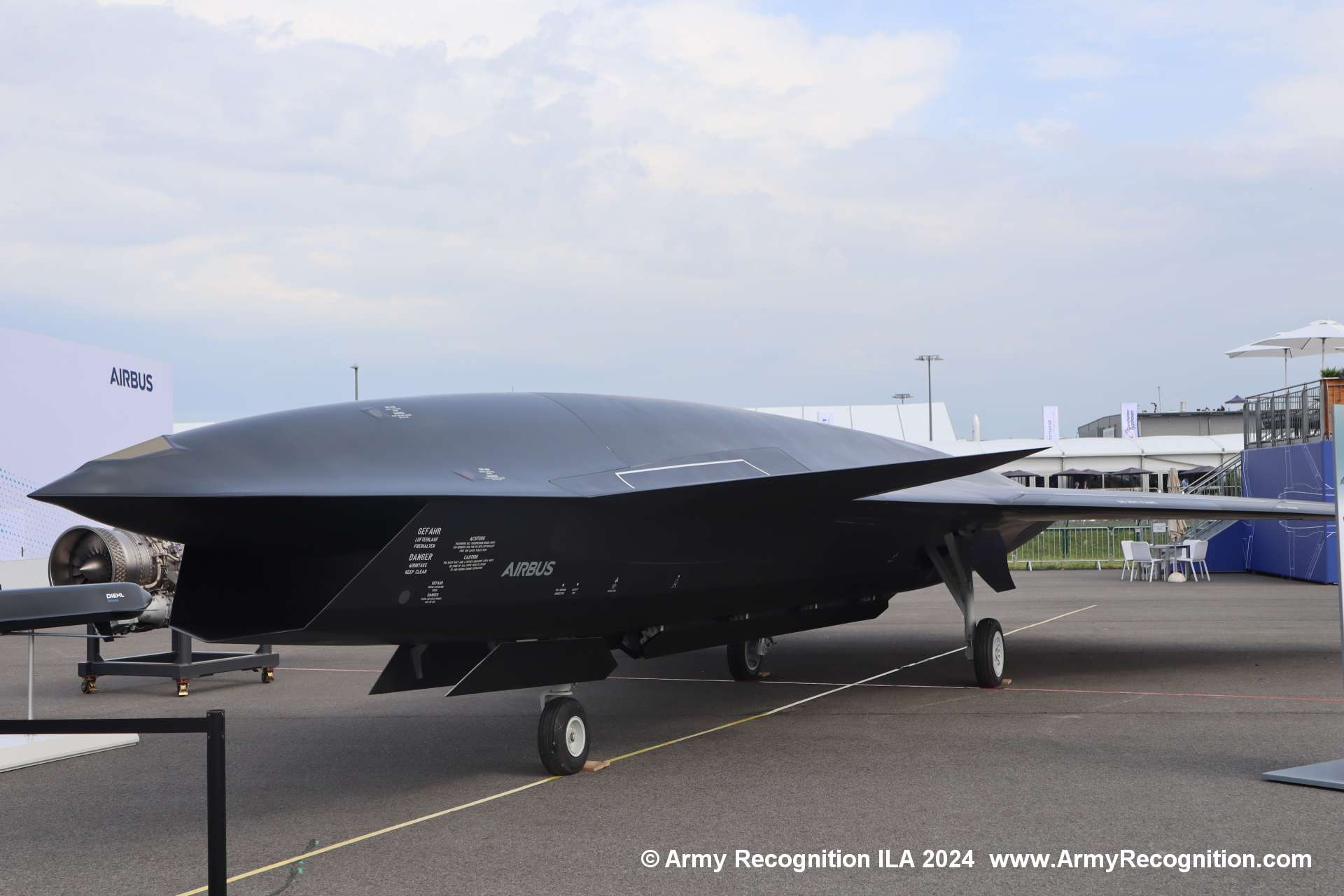Airbus Unveils Innovative Wingman Drone Concept at ILA 2024

{loadposition bannertop}
Breaking news
{loadposition sidebarpub}
At the International Aerospace Exhibition (ILA) in Berlin, Airbus Defence and Space introduced a revolutionary concept, the ‘Wingman’ combat drone, designed to supplement manned fighter jets like the Eurofighter. This new development is a response to the increasing operational demands of the German Air Force and aims to enhance the capabilities and safety of manned aircraft during missions.Follow Army Recognition on Google News at this link
The concept was presented through a 1:1 scale model at ILA, serving not only as a design demonstrator but also as a platform to refine operational features and integration of such unmanned systems into current and future air combat strategies (Picture source: ArmyRecognition)
The ‘Wingman’ concept, unveiled by Airbus, features a fighter-type drone controlled by a pilot, which will undertake high-risk tasks typically challenging for manned aircraft. This includes missions involving precision strikes, electronic warfare, and extensive reconnaissance, utilizing advanced sensors and connectivity to operate effectively alongside manned fighters.
A distinctive feature of the ‘Wingman’ is its focus on stealth capabilities. To maintain a very low radar signature, similar to that of advanced stealth aircraft like the B-21, the drone is designed with minimal angles and uses materials that absorb rather than reflect radar waves. Additionally, to preserve its stealthiness, all armaments and payloads are carried internally, ensuring the aircraft maintains a streamlined profile to minimize detection.
According to Michael Schoellhorn, CEO of Airbus Defence and Space, the German Air Force has clearly expressed the need for such unmanned systems to support its combat jets ahead of the upcoming Combat Air System, which is expected to be operational by 2040. Schoellhorn emphasized that the ‘Wingman’ is being developed to enhance the combat effectiveness and versatility of the existing fighter fleet, aiming to provide an affordable yet high-performing solution that could be crucial for the 2030s.
Furthermore, Airbus has announced a partnership with Helsing, a leading European defense AI and software company, to integrate artificial intelligence into the ‘Wingman’ system. This collaboration will focus on developing AI capabilities that can handle data from various sensors, optimize subsystems, and conduct electronic warfare, enhancing the autonomous operational capability of the ‘Wingman’.
The AI technologies developed by Helsing will play a critical role in enabling Wingman to perform complex tasks autonomously, thereby reducing the risk to human pilots while maintaining human oversight and control over critical decision-making processes.
In conclusion, Airbus Defence and Space is at the forefront of integrating unmanned systems with manned fighters, significantly contributing to the evolution of air combat strategies. The ‘Wingman’ project not only showcases Airbus’s innovative capabilities but also highlights the growing trend towards mixed fleets of manned and unmanned systems in modern warfare. As the ‘Wingman’ concept advances, it is expected to become an essential component of advanced air forces, potentially revolutionizing how air superiority is achieved in the future.

{loadposition bannertop}
Breaking news
{loadposition sidebarpub}
At the International Aerospace Exhibition (ILA) in Berlin, Airbus Defence and Space introduced a revolutionary concept, the ‘Wingman’ combat drone, designed to supplement manned fighter jets like the Eurofighter. This new development is a response to the increasing operational demands of the German Air Force and aims to enhance the capabilities and safety of manned aircraft during missions.
Follow Army Recognition on Google News at this link
The concept was presented through a 1:1 scale model at ILA, serving not only as a design demonstrator but also as a platform to refine operational features and integration of such unmanned systems into current and future air combat strategies (Picture source: ArmyRecognition)
The ‘Wingman’ concept, unveiled by Airbus, features a fighter-type drone controlled by a pilot, which will undertake high-risk tasks typically challenging for manned aircraft. This includes missions involving precision strikes, electronic warfare, and extensive reconnaissance, utilizing advanced sensors and connectivity to operate effectively alongside manned fighters.
A distinctive feature of the ‘Wingman’ is its focus on stealth capabilities. To maintain a very low radar signature, similar to that of advanced stealth aircraft like the B-21, the drone is designed with minimal angles and uses materials that absorb rather than reflect radar waves. Additionally, to preserve its stealthiness, all armaments and payloads are carried internally, ensuring the aircraft maintains a streamlined profile to minimize detection.
According to Michael Schoellhorn, CEO of Airbus Defence and Space, the German Air Force has clearly expressed the need for such unmanned systems to support its combat jets ahead of the upcoming Combat Air System, which is expected to be operational by 2040. Schoellhorn emphasized that the ‘Wingman’ is being developed to enhance the combat effectiveness and versatility of the existing fighter fleet, aiming to provide an affordable yet high-performing solution that could be crucial for the 2030s.
Furthermore, Airbus has announced a partnership with Helsing, a leading European defense AI and software company, to integrate artificial intelligence into the ‘Wingman’ system. This collaboration will focus on developing AI capabilities that can handle data from various sensors, optimize subsystems, and conduct electronic warfare, enhancing the autonomous operational capability of the ‘Wingman’.
The AI technologies developed by Helsing will play a critical role in enabling Wingman to perform complex tasks autonomously, thereby reducing the risk to human pilots while maintaining human oversight and control over critical decision-making processes.
In conclusion, Airbus Defence and Space is at the forefront of integrating unmanned systems with manned fighters, significantly contributing to the evolution of air combat strategies. The ‘Wingman’ project not only showcases Airbus’s innovative capabilities but also highlights the growing trend towards mixed fleets of manned and unmanned systems in modern warfare. As the ‘Wingman’ concept advances, it is expected to become an essential component of advanced air forces, potentially revolutionizing how air superiority is achieved in the future.





